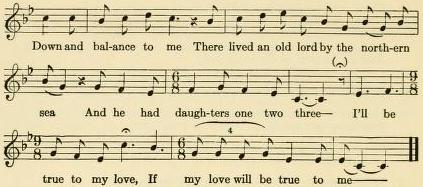Three Daughters- Johnson (NC) 1941 Brown 4-G
[From The Brown Collection of NC Folklore, 1952 which is one of the better US collections and has nine versions - five with music examples. A recording is available on Abrams Collection site with two verses- the second, almost unintelligible.
R. Matteson 2014]
OLDER BALLADS MOSTLY BRITISH: 4. The Two Sisters (Child 10)
4. The Two Sisters (Child 10)
For the range of this story in other lands and tongues, see Child's headnote; for its occurrence in Great Britain and America since Child's time, consult BSM 16-17 and add to the list there given Vermont (NGMS 3-4), Tennessee (BTFLS viii 71), North Carolina (FSRA 13), Florida (SFLQ viii 138-9), Arkansas (OFS I 50-2, 53-5, 59-60, 63), Missouri (OFS I 52-3, 55-8, 60-2), Ohio (BSO 17-8), Indiana (BSI 42-50), and Michigan (BSSM 32-4). Mr. Paul G. Brewster, who has made an intensive study (as yet unpublished) of this ballad, believes that, as ballad, it is definitely Scandinavian in origin, starting in Norway some time before the seventeenth century and spreading to Sweden, Denmark, the Faeroes (and thence to Iceland), Scotand, England, and America; and that the corresponding folk tale tradition is Slavic, probably Polish. The "singing bones" — the revelation of the crime by a fiddle made from the dead girl's body — have almost entirely vanished from American texts, but a trace of them is preserved in our version C. All but one of the versions in our collection belong to the common American tradition, marked by the "bow down" refrain.
G. 'The Twa Sisters.' Sung by Mrs. Anna Johnson. Recorded from the original procured by Dr. W. A. Abrams at North Wilkesboro, Wilkes county, September 14, 1941. The last four measures of our version show some relationship with those of the Horton Barker version.


For melodic relationship cf. **SharpK I, 31, No. 5G, almost throughout; FSSH 39, No. 4A and AMS 27. *DD 70-71 : compare our 'Down and balance to me' with 'Bowes down' and 'Bow and balance to me' ; also the beginning in both which recurs when the phrase is repeated. Likewise our last 6 measures with the last five of the other version. OFS I, 60, No. 4G. Compare the phrase 'daughters one, two, three.'
1. There lived an old lord by the northern sea,
Bow thee down,
There lived an old lord by the northern sea,
Down and balance to me,
There lived an old lord by the northern sea,
And he had daughters one, two, three,
I'll be true to you, my love,
If my love will be true to me.
2. The youngest one she had a beau,
Bow thee down,
The youngest one she had a beau,
Down and balance to me,
The youngest one she had a beau,
. . .
I'll be true to you, my love,
If my love will be true to me.